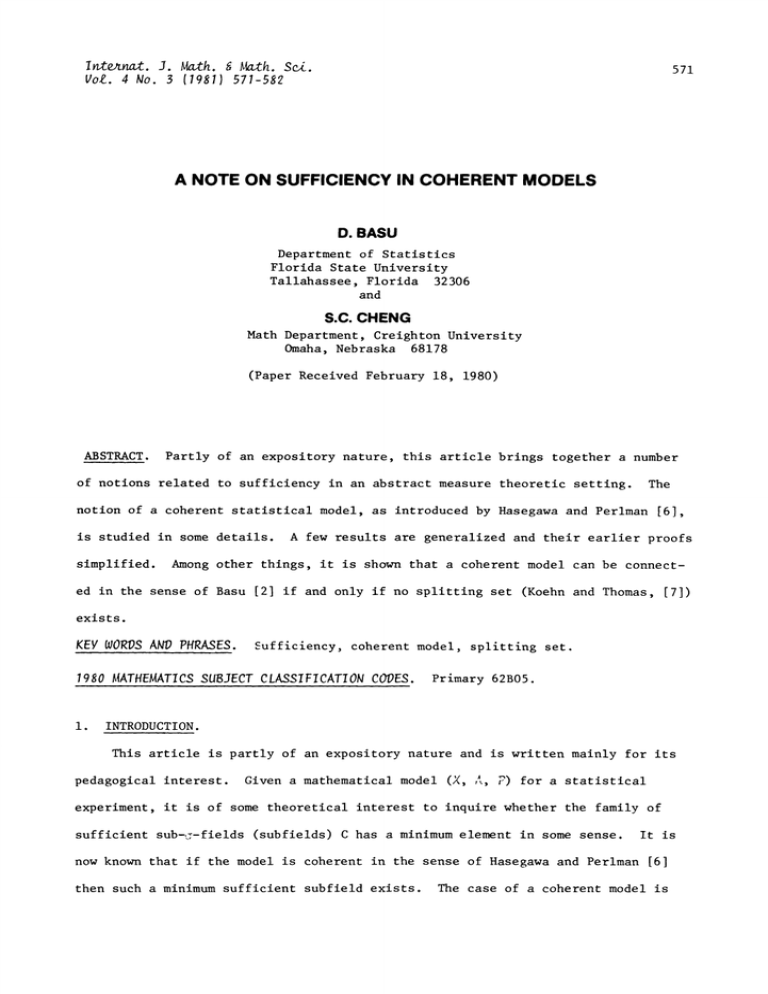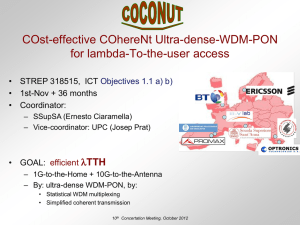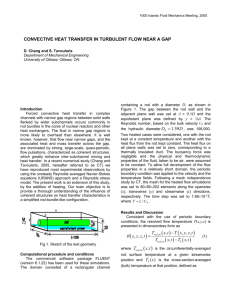A NOTE ON SUFFICIENCY IN COHERENT MODELS J. No. D.
advertisement

I ntern. J. Math. & Mh. Sci.
Vol. 4 No. 3 (1981) 571-582
571
A NOTE ON SUFFICIENCY IN COHERENT MODELS
D. BASU
Department of Statistics
Florida State University
Tallahassee, Florida 32306
and
S.C. CHENG
Math Department, Creighton University
Omaha, Nebraska 68178
(Paper Received February 18, 1980)
ABSTRACT.
Partly of an expository nature, this article brings together a number
of notions related to sufficiency in an abstract measure theoretic setting.
The
notion of a coherent statistical model, as introduced by Hasegawa and Perlman
is studied in some details.
simplified.
[6],
A few results are generalized and their earlier proofs
Among other things, it is shown that a coherent model can be
connect-
ed in the sense of Basu [2] if and only if no splitting set (Koehn and Thomas, [7])
exists.
KEY WORDS AND PHRASES.
Sufficiency, coherent model, splitting set.
1980 MATHEMATICS SUBJECT CLASSIFICATION CODES.
i.
Primary 62B05.
INTRODUCTION.
This article is partly of an expository nature and is written mainly for its
pedagogical interest.
Given a mathematical model
(X, rl, P) for
a statistical
experiment, it is of some theoretical interest to inquire whether the family of
sufficient sub-.-fields (subfields) C has a minimum element in some sense.
now known that if the model is coherent in the sense of Hasegawa and Perlman
then such a minimum sufficient subfield exists.
It is
[6]
The case of a coherent model is
D. BASU and S.C. CHENG
572
Among other things it is demonstrated
studied in some details in this article.
that for a coherent model the notion of connectedness (Basu, [2]) and that of
the nonexistence of a splitting set (Koehn and Thomas, [7]) coincide.
AND DEFINITIONS.
NOTATION
2.
{X, A, PI,
The basic statistical model is denoted by
A
space,
measures on
A.
BII.
{R1,
into
A
Any sub-u-field C of
f-iB i
by the family of sets.
ft
of all P-null sets.
The completion
exists a
is
,
A1
C-measurable
P-integrable if
DEFINITION i.
T} for the subfield generated
91,
{
9 we denote
C
D[P].
Let N denote the class
@.
g
"A
B [P]" means that the
Similarly, for any two
C
is defined as
C.
If
that is,
C and 9.
0 for all
P-null.
The
Given a family
A-measurable
{I.
C9[P]
Accordingly,
C,
9=C[P], then C
and
func-
N.
g
Let C and 9 be two subfields.
that is, corresponding to each set C in
C---measurable
C-measurable.
C.
t g
CV
By
the statement
is called complete if
9 such that C
i.e., f is
A,
of a subfield
9[P] if C c
P-essentially
a family of probability
g [P] to indicate that {x: f(x) # g(x)}
tions f and g, we write f
a set D g
Po(N)
For A, B
symmetric difference A A B is
C
@}
g
T} will stand for the smallest sub-
t g
C-measurable.
is
A set N in A is P-null if
write
0
(At:
write
the smallest subfield containing both
C
{P0:
is the sample
will be referred to as a subfield.
oft:
Likewise,
C such that each
a subfield
P
is contained in
T} of measurable sets, we
t g
field
and
X
By an A-measurable function we mean a measurable map of {X,
function f is C-measurable if
(At:
X,
a o-field of subsets of
where
function we mean a function f such that
We
there exists
9[P].
By a
f-18=C
i
[P],
This is also equivalent to the statement that there
function g such that f
fxlfld P0 <
for all O
(Halmos and Savage, [5]).
g
[P]. An A-measurable
@.
The statistical model
is called dominated if every probability measure in
with respect to a fixed o-finite measure % on
function
P
IX, A, P1
is absolutely continuous
A.
In this case, we say that the family is dominated by % and write P << %.
573
SUFFICIENCY IN COHERENT MODELS
(Basu and Ghosh, [3]).
DEFINITION 2.
{X, A, P1
The statistical model
is
called discrete if
(i)
each
A
(ii)
P0
is a discrete probability measure,
for each x g
(iii)
X,
is the class of all subsets of
X,
there exists a 0
and
Q such that
g
P0({x})
> 0.
Condition (iii) implies that the empty set is the only P-null set.
X
crete model with a countable sample space
is clearly dominated.
We assume that both
able, then the model is dominated.
X and P
If
P
A disis count-
are uncountable. In
As we shall see in the next section,
this case, the model will be undominated.
dominated and discrete models are particular cases of what Hasegawa and Perlman
[6] called a coherent model.
Finally, let us state the notion of sufficiency as follows.
is sufficient with respect to the model
A,
{X, A, P1 if,
there exists a C-measurable function I J" such that
corresponding to each A in
IA# E0(IAIC)
A
A, P1
A subfield C is pairwise sufficient with respect to {#(,
and each pair
A
3.
01, 02
E0i(IAIC) [P0i]
g
@,
A subfield
[P0]
for all 0
if, for each A in
there exists a C-measurable function I * such that
A
for i
(The function IA may depend on
i, 2.
eI
and
e2.)
COHERENT STATISTICAL MODEL.
Let
F
denote the class of all measurable functions f"
{f0: f0
s
be a collection of members of
F
F,
0
g
X
[0, i] and let
}
Let S
that is indexed by 0.
{s
be the family
of all such collections s.
A member
DEFINITION 3.
every pair
[P0i
for i
01, 02
in
,
{f0
of
S
is said to be pairwise coherent if, for
there exists a function
f12
in
F
such that
f0i f12
i, 2.
{fo} of S
every countable subfamily @0
{01’ 02
in F such that
foi f0[Poi] for all i
DEFINITION 5. A member {fo} of S
DEFINITION 4.
a function f in
F
A member
such that
f0 f[Po]
is said to be
of
countably coherent if, for
@, there
exists a function
f0
i, 2
.
is said to be coherent if there exists
for all 0
Q
D. BASU and S.C. CHENG
574
The statistical model
(Hasegawa and Perlman, [6]).
DEFINITION 6.
is said to be coherent if every countably coherent member of
S
is coherent.
In the following lemma, we show that the notions of pairwise coherence and
countable coherence do coincide.
LEMMA 1.
If
{fe}
S,
is a pairwise coherent member of
then it is countably
coherent.
each pair
e +/-’ e
in @
j
0’
fij
there exists a function
fi [Pe
and f
i
--{e
00
Choose and fix a countable subfamily
PROFF.
fij
in
l,
F
} of @.
e2,
For
such that
fej [Pj ].
ij
Let
g
For each fixed i, the functions
inf sup f
ij
i
j
and f
inf f
ij
i
h
sup f
ij’ j
j
i
are P@ -equivalent to
fil’ fi2’
fe." The
i
of Pe -equivalent functions is also Pe -equivalent
i
i
for each fixed j, we have
Likewise,
]"
[Pe
f@ i i
follows that gn
hn fen [Pen for n i, 2,
1
supremum of a countable number
Thus, gi
to those functions.
fo.[Pe.].
3
3
hj
Therefore, it
f !
Observe that hn
gn
f
Hence,
{fe}
gn
It then follows that
for all n.
hn fen [Pen
for n
i, 2,
is countably coherent.
In general, the notions of pairwise coherence and coherence do not coincide
as the following example shows.
EXAMPLE i.
(Pitcher, [I0]).
o-field of Borel subsets of
X,
and
Let
P
X
be the unit interval [0, i],
define
fe(x)
Pe({x}).
Then
{fe}
In this model, no proper subfield of
C be
or else are absolutely
P and each
is pairwise coherent, but not coherent.
A
can be sufficient.
an arbitrary sufficient subfield and let P
degenerate at x.
X
For each P O in
continuous with respect to the Lebsgue measure.
X,
the
the family of all probability measures on
which are either degenerate at a single point of
x
A
x
To see this, let
be the probability measure
Then it follows from the sufficiency of C that, for all A in
575
SUFFICIENCY IN COHERENT MODELS
A,
I such
there exists a C-measurable function
fX IA# dPx fX IAdPx IA(X)
l#(x)
A
{x:
Let C
that
IA#(X)
i}.
C e
Then A
(X, A, P)
We now show that the model
A.
Hence, C
C.
is coherent if it is either dominated
or discrete.
(Hasegawa and Perlman, [6]).
LEMMA 2.
If
(X, A, P)
is dominated, then it
is coherent.
PROOF.
@
{@
0
O
1’
f0
rf o}
is coherent.
function
and so
countably coherent.
F
f0
PROOF.
If
Then there exists a function
{X, A, P)
{fo}
81, 82
Suppose
such that
(C),
for all 8
so
Then there exists a
Thus,
i, 2,
n
fl[P0
f0
as required.
is discrete, then it is coherent.
We must show that it is also coherent.
be pairwise coherent.
X:
{x
Po({x})
> 0} denote the countable support of
in @, there exists a function
I, 2.
for i
{8}.
F
e
f0
fo[P8
f0
@i @0
@, consider
P
is equivalent to
0
f12
F
in
P@.
f12
such that
Thus, we have
1
1
fo.(x)
1
Hence, f
{8
@x
all 0
fO(x)
f8
@ e @
fl f8 n [P8 n for
Hence, f0
[P8
fl
@, let S 8
For each pair
{P 0
0
such that
Let
For each 8
fo.[Po.]
For each 8
fl [P]"
LEMMA 3.
P
We now show that
i, 2
for n
e
fl
is dominated, it follows that there is a countable subfamily
of @ such that
2’
{fo} is
f0 n [P8 n
that
P
Since
81
f
@:
g
@
(x)
x
x g
82
for all x g
(x) for all x
$8}.
Let
80
S
@x’
@
x
S
81
f8 0
82
(x)
evaluated at x, that is,
Now, choose and fix x e X.
@x"
Note that x
f0(x)
fo(x)
c
x
(i)
i, 2.
i
(for this prefixed x).
arbitrary, define a function f by f(x)
[Po]
$8.,
1
be a member of
In view of (1), we have
is constant in 8
for 8 e
fl2(X)
c
x
g
@
for all 8
Let c
x
X
x’
8
that is,
X.
Since x is
Clearly, f
f8
for all 8 e @ as required.
That the coherent case is not exhausted by the dominated and discrete
cases is shown in the following example.
for
be the common value of
for all x
for all x g
S
$80
Let
576
D. BASU and S.C. CHENG
EXAMPLE 2.
P21
PI
be a non-discrete dominated model, let
X 1 and X 2 are disjoint,
{Am X: AX
X I X2, A
Let X
1,
2},
and
e
P2 {Pc:
and extend
02}
S
Pe(AXi)
for all 8
It follows from Lemmas 2 and 3 that both
@}.
fo’
Each
{X, A, P)
Suppose that
f
A
i
for
{f@:
i, 2.
i
e@i,
{XI, AI, Pl
is also coherent, where
and
IX2, A2, P2
are coherent.
PI P2 {P@:
P
@ e @} is pairwise coherent with respect to
being an A-measurable function, can be written as
I
f0
where
g
i
P1 and P2 to A by defining
Pc(A)
Now we claim that
{X2, A2,
P1
be an undominated discrete model, where
{PC: e @i },
i
{XI, AI,
Let
is
Ai-measurable
with respect to
i
fe
on
XI
f
on
X2,
i, 2.
for i
(Xi, Ai, Pi
Since
{fi:@
8 e
@i },
being palrwise coherent
is coherent, it follows that there exists an
A i-
measurable function 0 < f.]. < i such that
fi
i
fe [P@]
for all 8 e
fl
on
X
f2
on
X2
@i"
Define
I
f
Clearly, f is A-measurable.
Therefore, f
f@[P@]
Observe that
for all @ e G.
f@ fi[P8]
8
for all @ e
@i
i
However, it should be noted that {X,
i, 2.
A, P)
is neither dominated nor discrete.
4.
SUFFICIENCY IN THE COHERENT CASE.
For each 8 e 0, let N denote the class of all
8
N@
{N e A:
P@(N)
0}.
For each subfield C of
[c
Then
is also a subfield of
A.
A,
Ps-null
sets, that is,
define
V
It is easy to see that a function f is C-measurable
577
SUFFICIENCY IN COHERENT MODELS
.
@, there
if and only if, for each @ e
Clearly, Cc
fs[P@..
f
Let
0
{X, A, P)
C of A.
{X, C, P}
X.
B
Let X be the real line and let
E, then
{X, B, P}
P
and @.
cannot be coherent.
{x: -x e E}.
f
-<
Let @ be also the
@} of probability measures as follows:
@
1/2 and 1/2 to
{f@:
}
@
To see this, for each @
j
(X, B, }.
@.
1/2
if
x e E
1
if
x
of all subsets of
Suppose, on the
TS.is impl.es that
E,
B.
which obviously contradicts the initial supposition that E
A
define
Then there exists a B-measurable function
for all @
f(x)
consider the class
X,
@ and each x E
P@({x}).
is coherent.
f@[P@]
1 such that f
We claim that
is degenerate at @.
P@
@ e -} is pairwlse coherent with respect to
contrary, that
-<
{Ps:
E, then
If @
f@(x)
{f@:
be the u-field of all Borel sub-
is the discrete measure allotting probabilities
P@
the two points -@
0
for any subfamily
Choose and fix a non-empty, non-Borel set E that excludes the origin
real line, and define a family
Then
such that
is coherent for every subfield
but is symmetric about the origin, i.e., E =-E
If @
P0
f@
Such an example is explicitly included in Pitcher’s [9] example.
EXAMPLE 3.
sets of
it is not true that
{X, A,
Then, so is
be a coherent model.
P. However,
of
C-measurable function
exists a
X,
then
(X, A, }
However, if we
is a discrete model and
hence is coherent.
,
In the following lemma, however, we show that if (X,
model, then so is
LEMMA 4.
If
{X,
A, P)
is a eoherent
) for any subfield C of A.
is a subfield of
A,
then
} be pairwise coherent with respect
to
(X,
(X, A, P)
is coherent and
C
is coherent.
PROOF.
Let
{f@:
@
Then it is also palrwise coherent with respect to
coherent, there exists an A-measurable function 0
for all @
@.
Since each
f@
is
-measurable,
{X, A, P).
K
Since
(X, C, P)
,
).
(X, A, P)
f < 1 such that f
it is seen that f must be
f@[P@]
is
.
D. BASU and S.C. CHENG
578
measurable with respect to
i, 0
i
P,
denote the convex hull of
Let
Za
This proves that
P
IX, A, P1
{Q: Q
is coherent if and only if
{X, A, Pl.
pairwise coherent with repsect to
}
IX, A, P1
a
>0,
i
is pairwise coherent with respect to
fQ[Q]
We now claim that f
O.
for all 0
Y.aiP0.,
where 0
i
g
for all Q
@, a i > 0, and Ea i
fi <-
-measurable function 0 <_
fi
.
{X, A, PI.
<g
is coherent.
{fQ"
{f0:0
Let
Then the subset
coherent, there exists an A-measurable function 0 < f
exists an
is coherent.
YaiP0.,
The "only if" part is what needs to be proved.
PROOF.
Then Q
P1
i
LEMMA 5.
{fQ:
that is,
,
{X,
Since
}
be
0} of
{X, A, P1
is
f0[P0]
i such that f
Choose and fix Q
For each pair Q,
i.
Q e
.
there
P0.’
1 such that
fQ[Q]
and
f[P0. ]"
fi f0.
1
1
Since
{P0.:
i, 2
i
}
Q, it follows that
f
f
l
Hence, f
fQ[Q]
Q [P0 i
f
i
A
such that
is closed for countable convex combinations
PROOF.
Since
C c C,
Q
fQ
(P01 + P0
f
f0
f0 i [P@i
coherent with respect to
function 0
f0
This shows that
LEMMA 7.
f0[P0].
P
P
Then Q
2
for i
.
i, 2.
P),
C c C.
then C
If
P
C.
Let f be a C-measurable
fo
01, 02 e @, let
Since {P0
P0 2 Q’ we have
1
that {f0:0 e @} is pairwise
For each pair
and so f
f [Q].
Q
Thus, we have shown
(X, C, P).
< i such that
(X, C, P)
(i.e., P
is coherent.
Then, for each 0 e @, there exists a C-measurable
i such that f
)/2.
{X, C, P)
it suffices to show that
function such that 0 < f < i.
function 0
i, 2,
as required.
Let C be a subfield of
LEMMA 6.
for i
Therefore, there exists a C-measurable
fo[P@]
for all @ e @, and hence f
is coherent if and only if
(X,
,
P)
f0[P].
is coherent.
579
SUFFICIENCY IN COHERENT MODELS
PROOF.
coherent with respect to
-<
function 0
a
,
Let us first prove the "only if" part.
{X,
g@ < I such that
-measurable
function 0 < f
P).
g@[P@].
for i
g@i[P@i
g12
respect to
{X, C, P).
function 0
_<
{X, C, P)
f < 1 such that f
there exists a C-measurable
81’ 82
foi[Poi
< i such that
Hence,
i, 2.
Since
g12
{g@:
8 e 8} be pairwise
{fs:
For each pair
< i such that f
12
12
there is a C-measurable function 0 <
that
,
For each @
f@
Let
f12
for i
i, 2.
gl 2 [P]’
it follows
IX, C, P).
to
is coherent, there exists a
for all @ g @.
.
C---measurable
Since there is a
have f
f
C-measurable
g@
f@[Ps]
{f@:
@ e } be pairwise coherent with respect
Therefore,
-
Then, it is also pairwise coherent with respect to
Thus, there exists a
@ e
Since
8 e } is pairwise coherent with
is coherent.
To prove the "if" part, let
e @, there exists
s[P8]
function 0 <
< 1 such that
f@[P@]
C-measurable function 0 < f < 1 such that f
for all 8 e @ as required.
for all
[P],
we
Under the assumption of coherence, we now prove a number of results on
sufficiency.
Suppose that (X, C, P) is coherent.
PROPOSITION i.
If C is palrwise
sufficient, then C is sufficient.
PROOF.
of
Chose and fix A e
E@(IAIC).
exists a
Thus,
C
Since
A.
f@<
<_ f12
<-i such that
f12
1 be a version
@i’ @2
is pairwise sufficient, for each pair
C-measurable function 0
{f@:
For each 8 e @, let 0 <
f
[P
’
there
for i
I, 2.
@ e } is pairwise coherent with respect to
is coherent, there exists a
for all @
@.
<-
C-measurable function 0
f < 1 such that f
That is, C is sufficient.
COROLLARY i.
Suppose that
(X, A, )
is coherent and
.
f@[P@]
If C is pairwise
sufficient, then C is sufficient.
PROOF.
Since
(X, A, P)
U
is
coherent, it follows from Lemma 4 that {X,
C, {X, U, P)
is coherent.
Since
is coherent.
Consequently, the result follows from Proposition i.
is coherent.
In view of Lemma 7,
,
P)
(X, C, P)
580
D. BASU and S.C. CHENG
CORALLARY 2.
sufficient and
PROOF.
G,
Let C
C
D
Cc
C
D[POl
P
02
PROOF.
that
{X,
,
Since
P)
{X, A, P)
Suppose that
Ol, 02
for all
{X, A, F)
is coherent.
O[P@I’ P@2
is also pairwise sufficient.
is coherent, it follows from Proposition 1 that
COROLLARY 3.
e @ and
C
is pairwise
is sufficient.
is pairwise sufficient and
it is easy to verify that
If
a @.
82
for all pairs 8 I,
P8
2
1
P) is coherent, then
{X, D,
Since
P[P8
Since
(X,
81, 82
,
P]
is sufficient.
C
is coherent and
,
for all
,
then
is coherent and
If
is sufficient.
is sufficient
it follows from Lemmas 4 and 7
In view of Corollary 2, we therefore conclude that )
is sufficient.
{X, A, P)
We now show that if
C.
sufficient subfield
PROOF.
IA
function
measurable.
that I
.
Let A
such that
Since
C
,
for all O
[Po]
for any
lemma.
C-measurable
Note that IA
there exists a C-measurable function
is
f
such
IA%)folC]dP8
IA% IC)HP
0.
Hence, I A
IA[P 8]
for all
8.
IA%
Since
is
C-measurable, it follows that
C.
Therefore,
PROPOSITION 2.
If
(X, A, P)
is coherent and
C
is sufficient, then
(X, C, P)
is coherent.
PROOF.
Since
C
is sufficient,
6
in view of Lemma 8.
is coherent, it follows from Lemma 4 and 7 that
5.
-
IA
f0[Po] and so
fX(IA- IA#)2de o /X(IA- l)fode o
/xfoEo(IA
.
.
U
is sufficient, there exists a
/xE@[(IA
A
.
’following
If C is sufficient, then
IA# E O(IAIC)
Thus, for each
I
A
To this end, we shall need the
(Pitcher, 1965).
LEMMA 8.
(X, C, P)
is coherent, then so is
(X, C, P)
Since
(X, A, P)
is coherent.
BASU’ S THEOREM.
As before,
(X, A, P)
is our basic model, where
P
{P@:
8 e @}.
Two
581
SUFFICIENCY IN COHERENT MODELS
probability measures
A in
A
PSI (A)
P81
and
P82
1 implies that
P
in
are said to be overlapping if, for any set
P82 (A) >
eI
We write
0.
<=>
82
If there exists a finite number of parameter points
overlap.
P8 i
if
and P
el, 82,
82
8k
such that
81
then we say
PS’
and
P8
<=>
82
are connected.
<=> 8k <=> 8’
<=>
The family
P
is called connected if
every pair of probability measures in the family are connected.
(Basu, [2]).
THEOREM i.
If T is a sufficient statistic,
and V is a statistic which is independent of T for all 8 e
P
is connected,
0, then the
distribution
of V does not depend on 8.
A set A in
A
is called
00’ @I’
splitting set if there is a partition
of @
such that
0
if 0
00
i
if 8
01
Ps(A)
The above theorem has been generalized by Koehn and Thomas [7] as follows:
THEOREM 2.
Let T be a sufficient statistic.
There exists a statistic V,
@, whose distribtuion depends on 8 if and only if
independent of T for all 8
there exists a splitting set.
We now demonstrate that the two notions of connectedness of
P
and the
nonexistence of a splitting set are equivalent in the coherent case.
LEMMA 9.
Let
{X, A, P)
be coherent.
Then
P
is connected if and only if
there exists no splitting set.
Clearly, the connectedness of P implies the nonexistence of a split-
PROOF.
For each 8 e 0, let A 8 be a set such that
ting set.
+B
@0
C
A8.
{8
not empty.
@:
Suppose that P is not connected.
P8
and
Ps0are, connected}.
For each 8
is pairwise coherent.
let
Since
Since
f8 IA 8"
(X, A, P)
Ps(As)
Choose and fix
P
is not
i and
80
E
connected,
.
Ps(B)
> 0 if
Let
i @\0
It is easy to show that
is coherent, there exists an
{fs:
8
is
}
A-measurable
582
D. BASU and S.C. CHENG
function 0 < f < i such that
Since
AO
IAe
Pe,
P0(A)
Ae
for all @ g @.
Let A-OgO 0
it is easily seen that
is the support of
Note that A
f[Pe]
P@(A@)
if @ g
@i"
P@(A)
i for all
g
A@.
00"
Thus,
g
0 for all
@I"
That nonexistence of a splitting set is weaker than the connectedness
property is seen from the following example.
EXAMPLE 4.
Let
P
be a family consisting of all two-point distributions and
the standard normal distribution.
Then
P
is not connected and this does not
possess a splitting set.
ACKNOWLEDGMENTS.
Work of the first author is partially support by NSF Grant
No. 79-04693.
REFERENCES
i.
Basu, D.
(1955).
On statistics independent of a complete sufficient
statistic.
Sankhya A, 15, 337-380.
2.
Basu, D.
(1958). On statistics independent of sufficient statistic.
Sankhya A, 20, 223-226.
3.
Basu, D.
and Ghosh, J.K. (1967). Sufficient statistics in sampling from a
finite universe. Proc. 36th Session Internat. Statist. (In ISI
Bulletin), 850-859.
4.
Cheng, S.C.
(1978).
Statistical
A Mathematical Study of Sufficiency and AdeRuac in
Theory. Ph.D. Thesis, submitted to the Florida State
University.
5.
Halmos, P. R. and Savage, L. J. (1949). Applications of the Radon-Nikodym
theorem to the theory of sufficient statistics. Ann. Math.
Statist.
20, 225-241.
6.
Hasegawa, M. and Perlman, M. D. (1974). On the existence of a minimal
sufficient subfield. Ann. Statist. 2, 1049-1055.
7.
Koehn, V. and Thomas, L. D. (1975). On statistics independent of a
sufficient statistic: Basu’s lema. American Statistician, 29,
40-43.
8.
Pathak, P. K.
9.
Pitcher, T. S. (1957). Sets of measures not admitting necessary and
sufficient statistics or subfield. Ann. Math. Statist. 28,
267-268.
i0.
(1975). Note on Basu’s lema.
The University of New Mexico.
Technical Report No. 308.
Pitcher, T. S. (1965). A more general property than domination for sets of
probability measures. Pacific J. Math. 15, 597-611.





